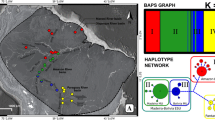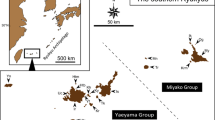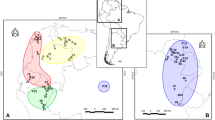Abstract
Cabot’s tragopan (Tragopan caboti) is a pheasant endemic to southeast China and is protected under both national and global legislation due to ongoing decline in population size and increased habitat fragmentation. We investigated the phylogeographic patterns and examined the consistency between evolutionary units and assumed subspecies taxonomy in this species. Six populations across the whole species presenting a wide distribution range were sampled and two mitochondrial DNA segments (control region, CR and cytochrome b, cyt b) were used in this study. The results demonstrated a high level of genetic diversity (h = 0.97 in CR and 0.78 in cyt b) and significant differentiation among populations. Phylogenetic analyses strongly indicated two reciprocally monophyletic clades named the “West group” and “East group” that were not consistent with the present subspecies regional distribution. The divergence time between the two groups was estimated to be around 5.54 × 105–8.7 × 105 years ago, and the expansion times of the two groups were close (about 3 × 105 years ago), indicating the effect of glaciation in intraspecific differentiation. Based on the results of genetic analyses combined with geographic isolation and distinct population history, our findings suggest that two management units (MUs) should be defined in T. caboti for conservation.





Similar content being viewed by others
References
Anisimova M, Gascuel O (2006) Approximate likelihood-ratio test for branches: a fast, accurate, and powerful alternative. Syst Biol 55:539–552
Armstrong DP, Seddon PJ (2008) Direction to reintroduction. Trends Ecol Evol 23:20–25
Avise JC (2000) Phylogeography. Harvard University Press, Cambridge
Avise JC, Nelson WS (1989) Molecular genetic relationships of the extinct dusky seaside sparrow. Science 243:646–649
Bandelt H-J, Forster P, Rohl A (1999) Median-joining networks for inferring intraspecific phylogenies. Mol Biol Evol 16:37–48
Benedict NG, Oyler-McCance SJ, Taylor SE, Braun CE, Quinn TW (2003) Evaluation of the eastern (Centrocercus urophasianus urophasianus) and western (Centrocercus urophasianus phaios) subspecies of sage-grouse using mitochondrial control-region sequence data. Conserv Genet 4:301–310
Brennan LA (1999) Northern bobwhite (Colinus virginianus) In: Poole A, Gill F (eds) The birds of North America. The Birds of North America, Inc., Philadelphia
Chen JK (1989) Systematic and evolutionary biology studies on Chinese Sagittaria. Wuhan University Press, Wuhan, China
Cheng TH, Wu MC (1979) A new subspecies of Tragopan caboti—Tragopan caboti guangxiensis. Acta Ecol Sin 25:292–294
Cheng TH, Tan YK, Lu TC, Tang CZ, Bao GJ, Li FL (1978) Fauna sinica. Aves vol. 4: galliformes. Science Press, Beijing
Collar NJ, Andreev AV, Chen S, Crosby MJ, Subramanya S, Tobias JA (2001) Threatened bids of Asia. Cambridge University Press, Cambridge
Crandall KA, Templeton AR (1993) Empirical tests of some predictions from coalescent theory with applications to intraspecific phylogeny reconstruction. Genetics 134:959–969
Crandall KA, Bininda-Emonds ORP, Mace GM, Wayne RK (2000) Considering evolutionary processes in conservation biology. Trends Ecol Evol 15:290–295
del Hoyo J, Elliott A, Sargatal J (1994) Handbook of the birds of the world, volume 2: new world vultures to Guinea fowl. Lynx Edicions, Barcelona, Spain
Deng WH, Zheng GM (2004) Landscape and habitat factors affecting Cabot’s tragopan Tragopan caboti occurrence in habitat fragments. Biol Conserv 117:25–32
Deng WH, Zheng GM, Zhang ZW, Garson PJ, McGowan PJK (2005) Providing artificial nest platforms for Cabot’s tragopan Tragopan caboti (Aves: Galliformes): a useful conservation tool? Oryx 39:158–163
Ding CQ, Zheng GM (1997) The nest site selection of the Cabot’s tragopan (Tragopan caboti). Acta Zool Sin 43:27–33
Eo SH, Wares JP, Carroll JP (2009) Subspecies and units for conservation and management of the northern bobwhite in the eastern United States. Conserv Genet 11:867–875
Excoffier L, Laval G, Schneider S (2005) Arlequin ver. 3.11: an integrated software package for population genetics data analysis. Evol Bioinform Online 1:47–50
Frankham R, Ballou JD, Briscoe DA (2002) Introduction to conservation genetics. Cambridge University Press, Cambridge
Fu YX (1997) Statistical tests of neutrality of mutations against population growth, hitchhiking and background selection. Genetics 147:915–925
Fuller RA, Garson PJ (2000) Pheasants: Status Survey and Conservation Action Plan 2000–2004. IUCN, Cambridge, UK
Guindon S, Gascuel O (2003) A simple, fast, and accurate algorithm to estimate large phylogenies by maximum likelihood. Syst Biol 52:696–704
Holder K, Montgomerie R, Friesen VL (2004) Genetic diversity and management of Nearctic rock ptarmigan Lagopus mutus. Can J Zool 82:564–575
Houlden BA, Costello BH, Sharkey D, Fowler EV, Melzer A, Ellis W, Carrick F, Baverstock PR, Elphinstone MS (1999) Phylogeographic differentiation in the mitochondrial control region in the koala, Phascolarctos cinereus (Goldfuss 1817). Mol Ecol 8:999–1011
IUCN (2008) IUCN Redlist of Threatened Species. IUCN, Gland, Switzerland
Kimball RT, Braun EL, Zwartjes P, Crowe TM, Ligon JD (1999) A molecular phylogeny of the pheasants and partridges suggests that these lineages are not monophyletic. Mol Phylogenet Evol 11:38–54
Klicka J, Zink RM (1997) The importance of recent ice ages in speciation: a failed paradigm. Science 277:1666–1669
Li SH, Yeung CK, Feinstein J, Han LX, Le MH, Wang CX, Ding P (2009) Sailing through the Late Pleistocene: unusual historical demography of an east Asian endemic, the Chinese Hwamei (Leucodioptron canorum canorum), during the last glacial period. Mol Ecol 18:622–633
Lovette IJ (2004) Mitochondrial dating and mixed support for the “2%” rule in birds. Auk 121:1–6
Moritz C (1994) Applications of mitochondrial DNA analysis in conservation: a critical review. Mol Ecol 3:401–411
Nei M (1987) Molecular evolutionary genetics. Columbia University Press, New York
Nesje M, Røed KH, Lifjeld JT, Linberg P, Steen OF (2000) Genetic relationships in the peregrine falcon (Falco peregrinus) analysed by microsatellite DNA markers. Mol Ecol 9:53–60
Nielsen R, Wakeley JW (2001) Distinguishing migration from isolation: an MCMC approach. Genetics 158:885–896
Peterson AT (1992) Philopatry and genetic differentiation in the Aphelocoma jays (Gorvidae). Biol J Linn Soc Lond 47:249–260
Posada D (2008) jModelTest: phylogenetic model averaging. Mol Biol Evol 25:1253–1256
Posada D, Crandall KA (2001) Intraspecific gene genealogies: trees grafting into networks. Trends Ecol Evol 16:37–45
Qian FW, Zheng GM (1993) Study on habitat of Cabot’s tragopan. J Beijing Norm Univ 29:256–264
Qu JY, Liu NF, Bao XK, Wang XL (2009) Phylogeography of the ring-necked pheasant (Phasianus colchicus) in China. Mol Phylogenet Evol 52:125–132
Randi E, Lucchini V (1998) Organization and evolution of the mitochondrial DNA control region in the avian genus Alectoris. J Mol Evol 47:449–462
Randi E, Lucchini V, Prewitt TA, Kimball RT, Braun EL, Ligon JD (2000) Mitochondrial DNA phylogeny and speciation in the tragopans. Auk 117:1003–1015
Randi E, Tabarroni C, Rimond S, Lucchini V, Sfougaris A (2003) Phylogeography of the rock partridge Alectoris graeca. Mol Ecol 12:2201–2214
Rogers AR, Harpending H (1992) Population growth curves in the distribution of pairwise genetic differences. Mol Biol Evol 19:522–569
Rozas J, Sáchez-delbarrio JC, Messeguer X, Rozas R (2003) DnaSP, DNA polymorphism analyses by the coalescent and other methods. Bioinformatics 19:2496–2497
Sorenson MD, Fleischer RC (1996) Multiple independent transpositions of mitochondrial DNA control region sequences to the nucleus. Proc Natl Acad Sci USA 93:15239–15243
Spaulding AW, Mock KE, Schroeders MA, Warheit KI (2006) Recency, range expansion, and unsorted lineages: implications for interpreting neutral genetic variation in the sharp-tailed grouse (Tympanuchus phasianellus). Mol Ecol 15:2317–2332
Sun YH, Zheng GM (1992) The home range of Cabot’s tragopan by radio tracking. Acta Zool Sin 38:385–392
Sun Y, Dong L, Zhang YY, Zheng GM, Browne SJ (2009) Is a forest road a barrier for Cabot’s tragopan in Wuyishan, Jiangxi, China? Oryx 43:614–617
Swofford DL (2002) PAUP*: phylogenetic analysis using parsimony (*and other methods). Version 4.0b10. Sinauer Associates, Sunderland, MA
Tajima F (1983) Evolutionary relationship of DNA sequences in finite populations. Genetics 105:437–460
Tajima F (1989) Statistical method for testing the neutral mutation hypothesis by DNA polymorphism. Genetics 123:585–595
Tamura K, Dudley J, Nei M, Kumar S (2007) MEGA4: Molecular Evolutionary Genetics Analysis (MEGA) software version 4.0. Mol Biol Evol 24:1596–1599
Winnepenninckx B, Backeljau T, De Wachter R (1993) Extraction of high molecular weight DNA from molluscs. Trends Genet 9:407
Young L, Zheng GM, Zhang ZW (1991) Winter movements and habitat use by Cabot’s tragopan Tragopan caboti in southeastern China. Ibis 133:121–126
Zhang YY (2005) A review on the research of the Cabot’s tragopan. Chin J Zool 40:104–107
Zhang YY (2006) Semen characterization and sperm storage in Cabot’s tragopan. Poult Sci 85:892–898
Zhang JP, Zheng GM (1990) The studies of the population number and structure of Cabot’s tragopan (Tragopan caboti). Zool Res Sin 11:201–207
Zhang YY, Zheng GM (2007) A population viability analysis for Cabot’s tragopan (Tragopan caboti) in Wuyanling, southwest China. Bird Conserv Int 17:151–161
Zheng GM (1987) Tragopan caboti. Chin J Zool 22:40–43
Zheng GM, Wang QS (1988) China red data book of endangered animals. Science Press, Beijing
Zheng GM, Zhao XR, Song J, Liu ZX, Zhou HQ (1985) On the breeding ecology of Cabot’s tragopan. Acta Ecol Sin 5:379–385
Zink RM (2004) The role of subspecies in obscuring avian biological diversity and misleading conservation policy. Proc R Soc Lond B Biol Sci 271:561–564
Zink RM, Barrowclough GF (2008) Mitochondrial DNA under siege in avian phylogeography. Mol Ecol 17:2107–2121
Zink RM, Barrowclough GF, Atwood JL, Blackwell-Rago RC (2000) Genetics, taxonomy and conservation of the threatened California gnatcatcher. Conserv Biol 14:1394–1405
Zou FS, Lim HC, Marks BD, Moyle RG, Sheldon FH (2007) Molecular phylogenetic analysis of the grey-cheeked Fulvetta (Alcippe morrisonia) of China and Indochina: a case of remarkable genetic divergence in a ‘species’. Mol Phylogenet Evol 44:165–174
Acknowledgments
We thank all staff in Wuyishan National NR (Jiangxi), Jiulianshan National NR and Wuyanling National NR, for their support in field work and sample collections. We also thank Li Li in Hunan Wildlife Rescue Center, Zuhao Huang in Jinggangshan University and Tailin Yu in Guangxi Normal University for the sample collections. This study was supported by the National Key Technology R&D Program of China (no. 2008BAC39B05) and the National Natural Science Foundation of China (no. 30670289).
Author information
Authors and Affiliations
Corresponding author
Rights and permissions
About this article
Cite this article
Dong, L., Zhang, J., Sun, Y. et al. Phylogeographic patterns and conservation units of a vulnerable species, Cabot’s tragopan (Tragopan caboti), endemic to southeast China. Conserv Genet 11, 2231–2242 (2010). https://doi.org/10.1007/s10592-010-0108-6
Received:
Accepted:
Published:
Issue Date:
DOI: https://doi.org/10.1007/s10592-010-0108-6




